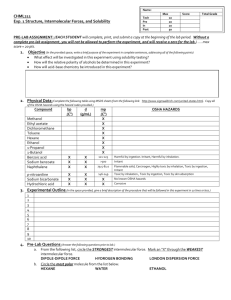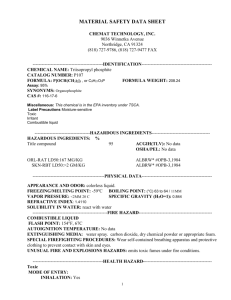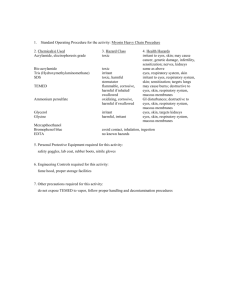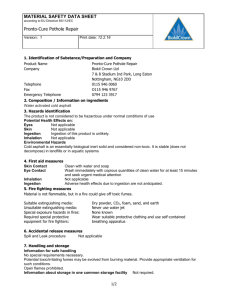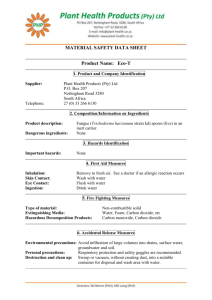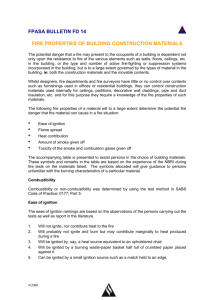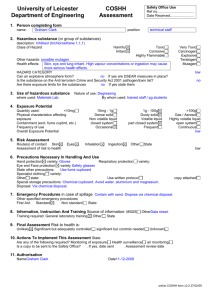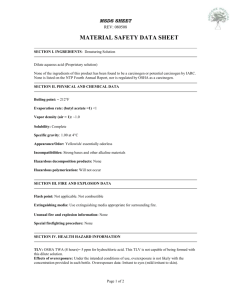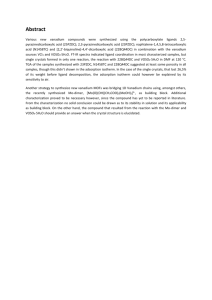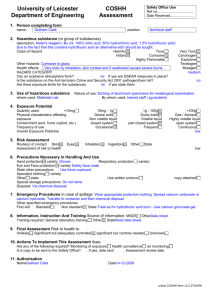Document - Chemat Scientific
advertisement
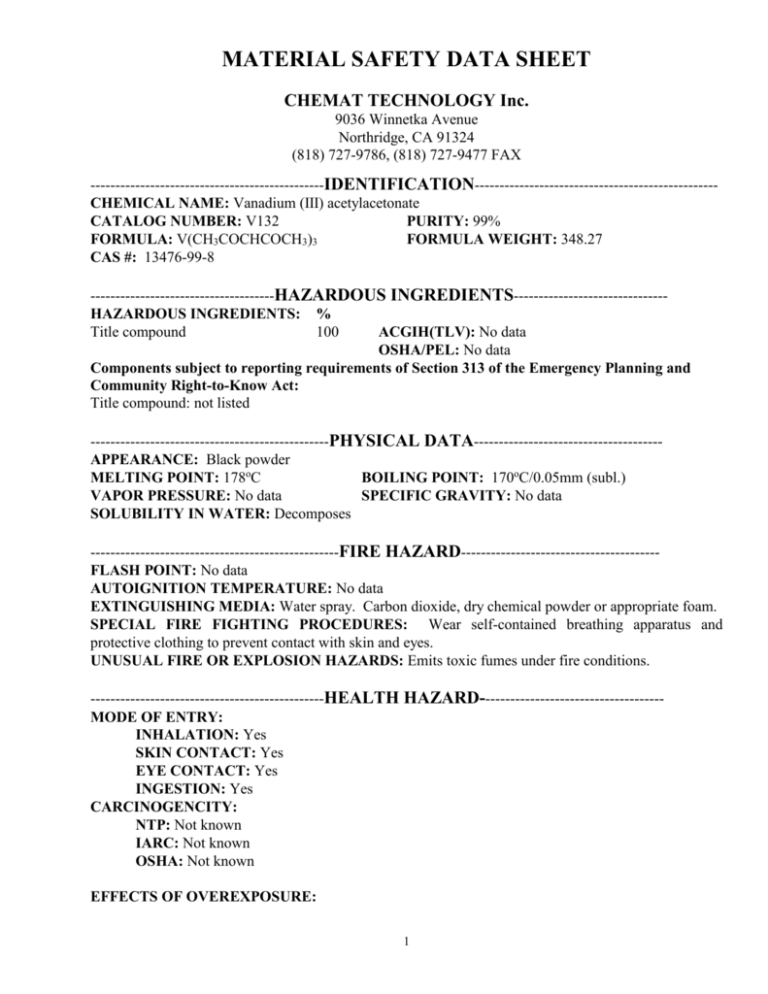
MATERIAL SAFETY DATA SHEET CHEMAT TECHNOLOGY Inc. 9036 Winnetka Avenue Northridge, CA 91324 (818) 727-9786, (818) 727-9477 FAX -----------------------------------------------IDENTIFICATION------------------------------------------------CHEMICAL NAME: Vanadium (III) acetylacetonate CATALOG NUMBER: V132 PURITY: 99% FORMULA: V(CH3COCHCOCH3)3 FORMULA WEIGHT: 348.27 CAS #: 13476-99-8 -------------------------------------HAZARDOUS INGREDIENTS------------------------------HAZARDOUS INGREDIENTS: % Title compound 100 ACGIH(TLV): No data OSHA/PEL: No data Components subject to reporting requirements of Section 313 of the Emergency Planning and Community Right-to-Know Act: Title compound: not listed ------------------------------------------------PHYSICAL DATA-------------------------------------APPEARANCE: Black powder MELTING POINT: 178oC BOILING POINT: 170oC/0.05mm (subl.) VAPOR PRESSURE: No data SPECIFIC GRAVITY: No data SOLUBILITY IN WATER: Decomposes --------------------------------------------------FIRE HAZARD---------------------------------------FLASH POINT: No data AUTOIGNITION TEMPERATURE: No data EXTINGUISHING MEDIA: Water spray. Carbon dioxide, dry chemical powder or appropriate foam. SPECIAL FIRE FIGHTING PROCEDURES: Wear self-contained breathing apparatus and protective clothing to prevent contact with skin and eyes. UNUSUAL FIRE OR EXPLOSION HAZARDS: Emits toxic fumes under fire conditions. -----------------------------------------------HEALTH HAZARD------------------------------------MODE OF ENTRY: INHALATION: Yes SKIN CONTACT: Yes EYE CONTACT: Yes INGESTION: Yes CARCINOGENCITY: NTP: Not known IARC: Not known OSHA: Not known EFFECTS OF OVEREXPOSURE: 1 Vanadium compounds act chiefly as irritant to the conjunctivae and respiratory tract. Prolonged exposure may lead to pulmonary involvement. There is still some controversy as to the effects of industrial exposure on other systems of the body. Responses are acute, never chronic. Symptoms and signs of poisoning are pallor, greenish-black discoloration of the tongue, paroxsymal cough, conjunctivitis, dyspnea and pain in the chest, bronchitis, rales and rhonchi, bronchospasm, tremor of the fingers and arms, radiographic reticulation. Vanadium compounds are common air contaminants. ACUTE EFFECTS: Harmful if swallowed, inhaled, or absorbed through skin. Causes eye and skin irritation. Material is irritating to mucous membranes and upper respiratory tract. May cause nervous system disturbances. CHRONIC EFFECTS: Overexposure may cause reproductive disorders based on tests with lab animals. May liberate 2,4-pentanedione upon decomposition. 2,4-pentanedione has the following toxicological hazards: toxic, irritant, neurological hazards, teratogen, possible mutagen. Target organs: thymus. In humans, 2,4-pentanedione is reported to cause contact dermatitis and contact urticaria. EMERGENCY AND FIRST AID PROCEDURES: INHALATION: Remove the victim to fresh air and seek medical attention if coughing, shortness of breath or irritation persists. SKIN CONTACT: Wash the affected area with ethanol first, then soap and water for at least 5 minutes. EYE CONTACT: Immediately flush eyes, including under eyelids, with large amounts of water for at least 15 minutes. Call a physician. INGESTION: Give the victim plenty of water and seek immediate medical attention. -----------------------------------------------REACTIVITY DATA----------------------------------STABILITY: Moisture-sensitive material. CONDITIONS TO AVOID: Exposure to air, moisture, heat. INCOMPATIBILITIES: Strong oxidizing agents. May decompose on exposure to air. Strong bases. Strong reducing agents. HAZARDOUS DECOMPOSITION PRODUCTS: Toxic fumes of carbon monoxide, carbon dioxide and organic vapors. HAZARDOUS POLYMERIZATION: None ---------------------------------ENVIRONMENTAL INFORMATION------------------------SPILL OR LEAKAGE PROCEDURES: Wear self-contained breathing apparatus, rubber boots and heavy rubber gloves. Sweep up, place in a bag and hold for waste disposal. Avoid raising dust. Ventilate area and wash spill site after material pickup is complete. WASTE DISPOSAL: Consult state, local, or federal EPA regulations for proper disposal. ----------------------------------PROTECTION AND PRECAUTIONS-----------------------VENTILATION REQUIREMENTS: Glove bag or box with dry, inert atmosphere. RESPIRATORY PROTECTION: NIOSH/MSHA approved respirator with an organic vapor cartridge. PROTECTIVE GLOVES: Rubber EYE/FACE PROTECTION: ANSI approved safety goggles HANDLING AND STORAGE: Handle and store the material underan inert atmosphere of nitrogen or argon. Keep away from heat. OTHER PRECAUTIONS: The material will react with moisture. Lab coat and apron, flame and chemical resistant coveralls, eyewash capable of sustained flushing, safety drench shower and hygienic 2 facilities for washing. The material is toxic, irritant. It’s a possible teratogen, neurological hazard. Must be kept tightly closed. ------------------------------------------------------------------------------------------------------------------------------The information herein is believed to be accurate and reliable as of the date compiled. However, Chemat Technology, Inc. makes no representation, warranty or guarantee of any kind with respect to the information on this data sheet or any use of the product based upon this information. DATE PREPARED: December 1997 3
